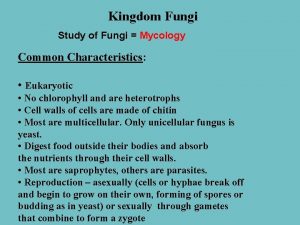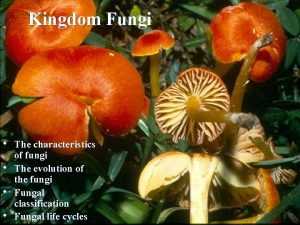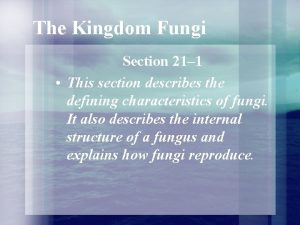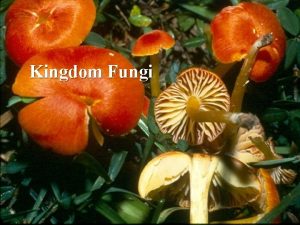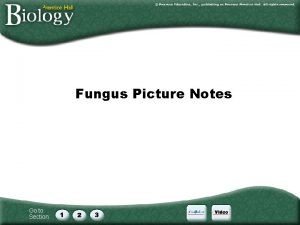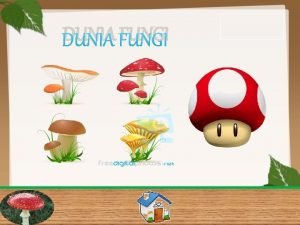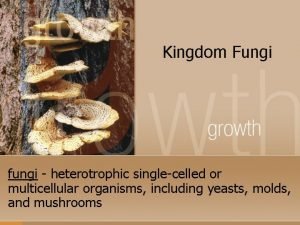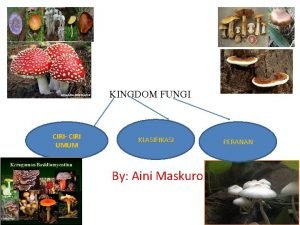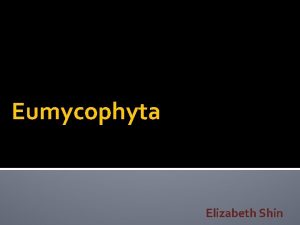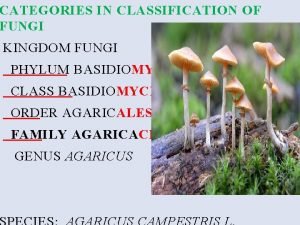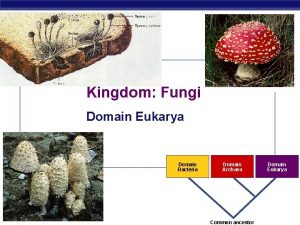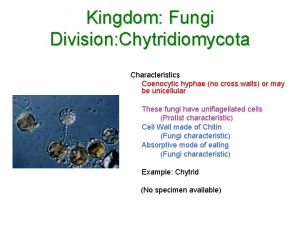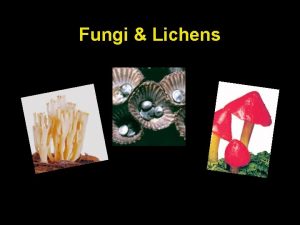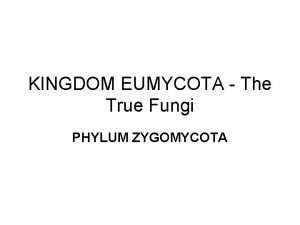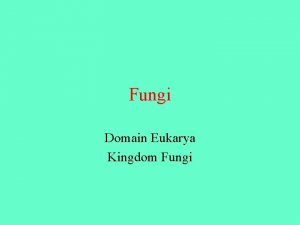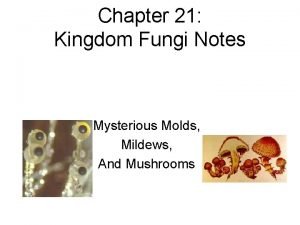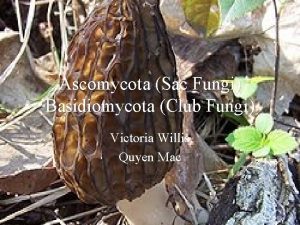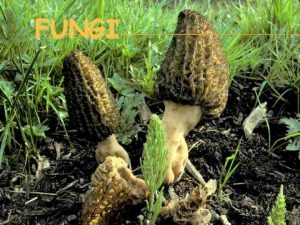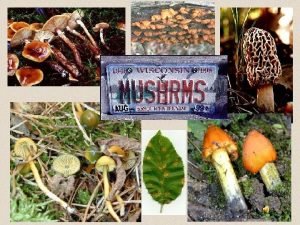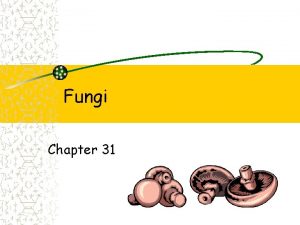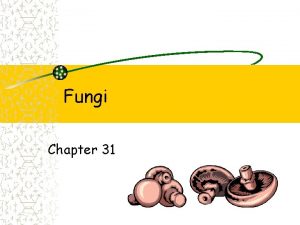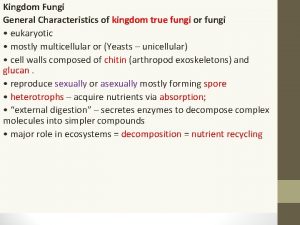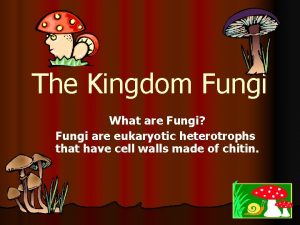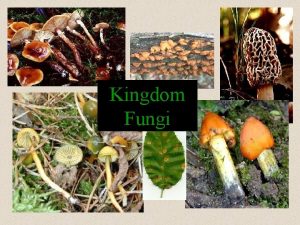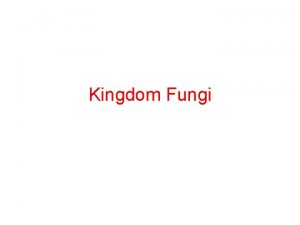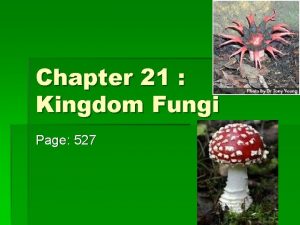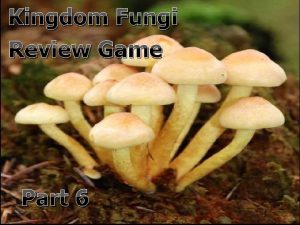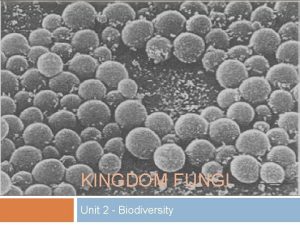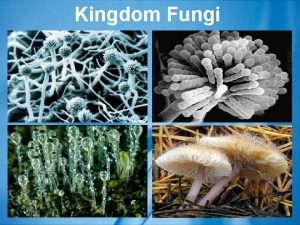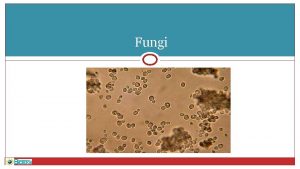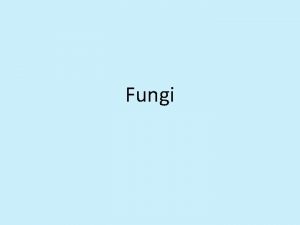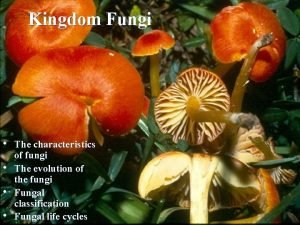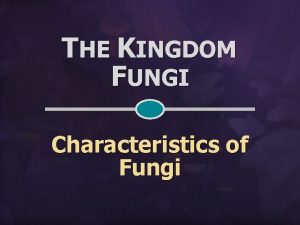KINGDOM FUNGI 1 THE CHARACTERISTICS OF FUNGI Fungi





































- Slides: 37

KINGDOM FUNGI 1

THE CHARACTERISTICS OF FUNGI Fungi are NOT plants Non-photosynthetic Eukaryotes Nonmotile Most are saprobes (live on dead organisms) 2

THE CHARACTERISTICS OF FUNGI Absorptive heterotrophs (digest food first & then absorb it into their bodies Release digestive enzymes to break down organic material or their host Store food energy as glycogen BREAD MOLD 3

THE CHARACTERISTICS OF FUNGI Important decomposers & recyclers of nutrients in the environment Most are multicellular, except unicellular yeast Lack true roots, stems or leaves MULTICELLULAR MUSHROOM UNICELLULAR YEAST 4

THE CHARACTERISTICS OF FUNGI Cell walls are made of chitin (complex polysaccharide) Body is called the thallus Grow as microscopic tubes or filaments called hyphae that grow into the food. 5

THE CHARACTERISTICS OF FUNGI Some are edible, while others are poisonous EDIBLE POISONOUS 6

THE CHARACTERISTICS OF FUNGI Produce both via sexually and asexually via spores Classified by their sexual reproductive structures Spores come in various shapes 7

THE CHARACTERISTICS OF FUNGI Grow best in warm, moist environments Mycology is the study of fungi Mycologists study fungi A fungicide is a chemical used to kill fungi Fungicide kills leaf fungus 8

THE CHARACTERISTICS OF FUNGI Fungi include puffballs, yeasts, mushrooms, toadstools, rusts, smuts, ringworm, and molds Penicillium mold Puffball 9

BENEFITS TO HUMANS Prevent the spread of pathogenic diseases caused by bacteria The antibiotic penicillin is made by the Penicillium mold Prevent growth of some cancer cells Treat human diseases 10

HYPHAL GROWTH Hyphae grow from their tips Mycelium is an extensive, feeding web of hyphae Mycelia are the ecologically active bodies of fungi This wall is rigid Only the tip wall is plastic and stretches 11

SPORES Spores are an adaptation to life on land Ensure that the species will disperse to new locations Each spore contains a reproductive cell that forms a new organism Nonmotile Dispersed by wind 12

SEXUAL REPRODUCTION Haploid 1 n hyphae from 2 mating types (+ and -) FUSE (Fertilization) Forms a hyphae with 2 nuclei that becomes a ZYGOTE The zygote divides to make a SPORE + SPORE FORMS 13

THREE TYPES OF ASEXUAL REPRODUCTION Fragmentation – part of the mycelium becomes separated & begins a life of its own Budding – a small cell forms & gets pinched off as it grows to full size Used by yeasts Asexual spores – production of spores by a single mycelium 14

REPRODUCE BY SPORES Spores may be Formed: Directly on hyphae Inside sporangia On Fruiting bodies Penicillium hyphae Amanita fruiting body Pilobolus sporangia

ASEXUAL REPRODUCTION Fruiting Bodies are modified hyphae that make asexual spores An upright stalk called the Sporangiosphore supports the spore case or Sporangium 16

ASEXUAL REPRODUCTION Types of Fruiting Bodies: Basidia Sporangia Ascus Sporangia Basidia 17

Fruiting Bodies Both are composed of hyphae mycelium 18

HYPHAL GROWTH FROM SPORE Germinating spore Mycelia mycelium have a huge surface area More surface area aids digestion & absorption of food 19

IT’S ALL ABOUT THE SPORES! Spores are everywhere! Wind, animals, water, & insects spread spores Spores germinates when they land on a moist surface (new hyphae form) 20

MAJOR GROUPS OF FUNGI Basidiomycota – Club Fungi Zygomycota – Bread Molds Ascomycota – Sac Fungi Lichens – Symbiosis (algae & Fungi)

ZYGOMYCOTA 22

ZYGOMYCOTA Called the sporangium fungi Commonly called molds Also includes blights Grow rapidly Includes bread mold Rhizopus on strawberries Tomato Blight

BASIDIOMYCOTA 24

BASIDIOMYCOTA Called Club fungi Includes: Mushrooms Toadstools Bracket & Shelf fungi Puffballs Stinkhorns Rusts and smuts

USES FOR BASIDIOMYCOTA Some are used as food (mushrooms) Others damage crops (rusts & smuts) Corn Smut Portobello Mushrooms Soybean Rust

ASCOMYCOTA 27

Called CHARACTERISTICS Sac fungi Includes Cup fungi, morels, truffles, yeasts, and mildew May be plant parasites (Dutch elm disease and Chestnut blight) Reproduce sexually & asexually

CHARACTERISTICS Yeasts reproduce asexually by budding (buds break off to make more yeast cells) Asexual spores called conidia form on the tips of special hyphae called conidiophores CONIDIA

YEASTS BUDDING Saccharomyces

USES OF ASCOMYCETES Truffles and morels are good examples of edible ascomycetes Penicillium mold makes the antibiotic penicillin. Some ascomycetes also gives flavor to certain cheeses. Saccharomyces cerevesiae (yeast) is used to make bread rise and to ferment beer & wine.

MYCORRHIZAE 32

MYCORRHIZAES Fungus associated with plant roots Mutualism between: Fungus (nutrient & water uptake for plant) Plant (carbohydrate for fungus) Extremely important ecologically Fixes nitrogen for plants 33

LICHENS 34

LICHENS Mutualism between: Fungus (structure) Algae or cyanobacteria (provides food) Form a thallus (body)

LICHEN STRUCTURE 36

LICHENS AS BIOMONITORS Some species more sensitive than others to pollutants and can indicate air quality Bio-indicators of climate change Lichens are in important food source for herbivores in the tundra 37
 Old kingdom middle kingdom new kingdom
Old kingdom middle kingdom new kingdom Nnn ruled
Nnn ruled Youtube egypt
Youtube egypt Capital of egypt during the old kingdom
Capital of egypt during the old kingdom Protista mobility
Protista mobility Plantae kingdom drawing
Plantae kingdom drawing Domain eukarya, kingdom plantae
Domain eukarya, kingdom plantae General characteristics of fungi
General characteristics of fungi Yeast kingdom
Yeast kingdom What is fungi characteristics
What is fungi characteristics Domain of kingdom fungi
Domain of kingdom fungi What kingdom is considered the ods and ends kingdom?
What kingdom is considered the ods and ends kingdom? Section 21-1 the kingdom fungi
Section 21-1 the kingdom fungi Fungal cell walls are characteristic in having
Fungal cell walls are characteristic in having Concept map of kingdom fungi
Concept map of kingdom fungi Peta konsep kingdom fungi lengkap
Peta konsep kingdom fungi lengkap Monera, protista, fungi, plantae animalia
Monera, protista, fungi, plantae animalia Fungi domain
Fungi domain Bentuk simbiosis chytridiomycota
Bentuk simbiosis chytridiomycota Are all fungi multicellular
Are all fungi multicellular Is kingdom fungi unicellular or multicellular
Is kingdom fungi unicellular or multicellular Fragmentasi miselium
Fragmentasi miselium Phylum eumycophyta
Phylum eumycophyta Classification of fungi
Classification of fungi Contoh jamur uniseluler
Contoh jamur uniseluler Domain eukarya kingdom fungi
Domain eukarya kingdom fungi Mushroom division
Mushroom division Sac fungi characteristics
Sac fungi characteristics Sexual reproductive structure of zygomycota
Sexual reproductive structure of zygomycota Domain vs kingdom
Domain vs kingdom Fungi examples
Fungi examples Basidiomycota club fungi
Basidiomycota club fungi Basidiomycota rusts and smuts
Basidiomycota rusts and smuts Deuteromycetes
Deuteromycetes Hình ảnh bộ gõ cơ thể búng tay
Hình ảnh bộ gõ cơ thể búng tay Bổ thể
Bổ thể Tỉ lệ cơ thể trẻ em
Tỉ lệ cơ thể trẻ em








